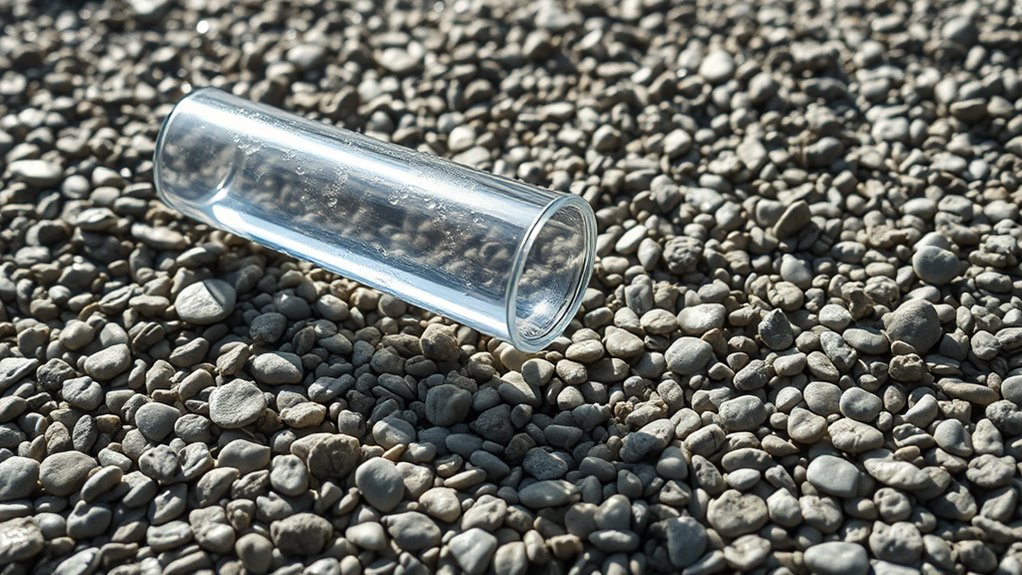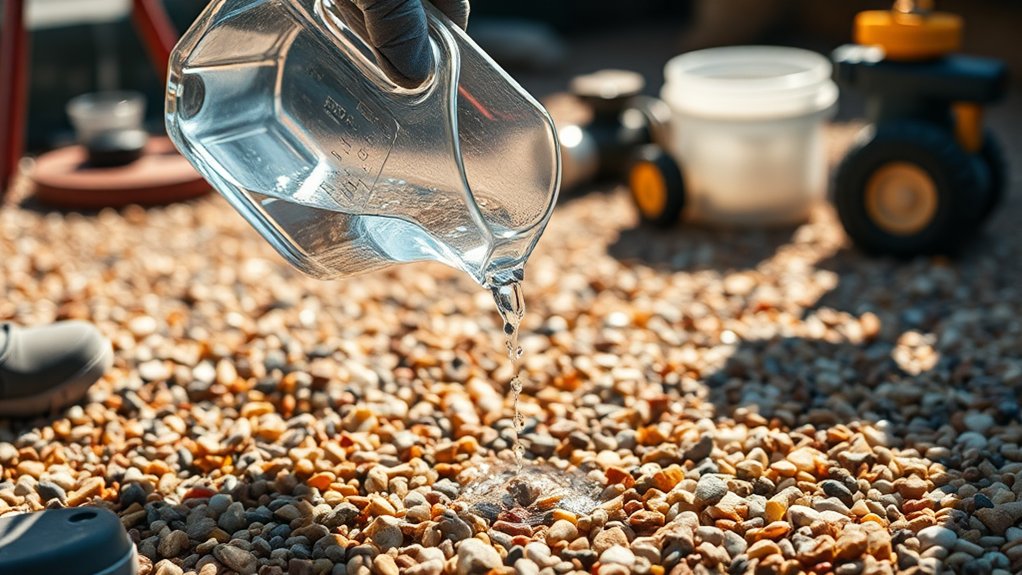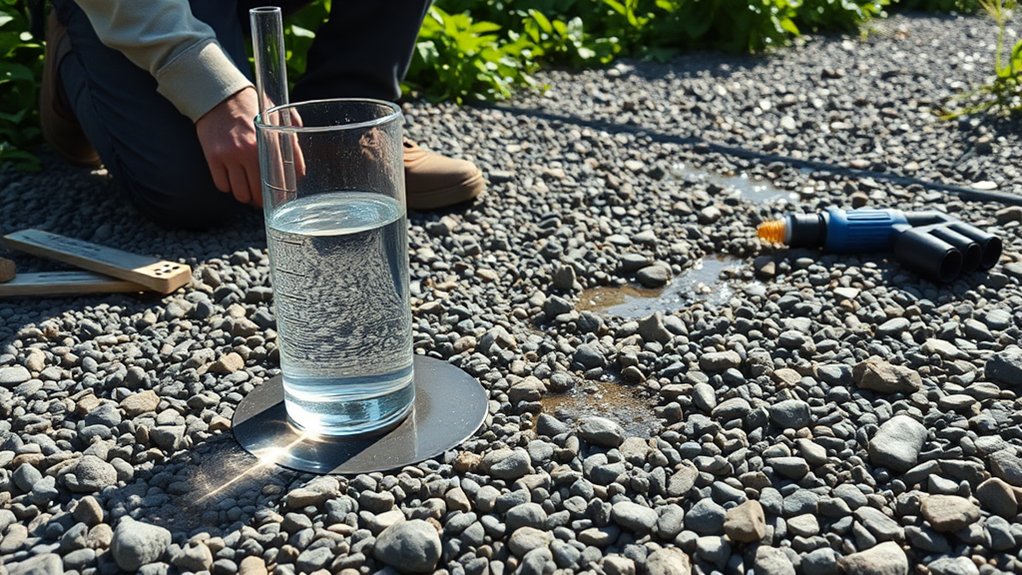Testing permeability in resin-bound gravel surfaces requires either a Falling Head Permeability Test or Infiltration Ring Method. These tests measure how quickly water drains through the surface – crucial for British weather conditions.
For reliable results, ensure the ground is properly prepped and stick to the correct resin-to-aggregate ratio (typically 1:4). Think of it like making tea – too much or too little water affects the outcome.
Keep the surface free from leaves and debris, particularly during autumn, and check regularly for blocked areas. A simple test is pouring a bucket of water on the surface – it should drain within minutes without pooling.
Key Takeaways
Five Key Methods to Test Resin-Bound Gravel Permeability:
1. Falling Head Test
Simple but precise way to measure water drainage – pour a measured amount of water and time how quickly it passes through. Perfect for getting exact figures for planning permission.
2. Infiltration Ring Test
Place a hollow ring on the surface, fill with water and monitor drainage speed. Dead simple on-site check that any builder can do.
3. Visual Check
Pour a bucket of water across the surface – it should drain quickly without pooling. Look for patches where water sits about, as these signal trouble spots.
4. Sub-base Assessment
Check the stone base is properly laid and compacted before testing. A dodgy sub-base will skew your results, no matter how good the surface looks.
5. Mix Ratio Check
Too much resin clogs the gaps between stones. The mix should be just enough to bind – typically 7-8% resin to aggregate. Think pouring milk over cereal – you want it coated, not swimming.
Understanding Resin-Bound Gravel Permeability

Resin-bound gravel is one of the most effective permeable paving solutions available in the UK today. Its porous structure lets rainwater drain through naturally, with a remarkable 95% permeability rate. Think of it like a sponge – instead of water pooling on top or running off into drains, it seeps straight through the surface.
This drainage ability makes it particularly useful for British weather, helping prevent waterlogging and flooding during heavy downpours. The material combines stone aggregates with resin to create a sturdy surface that’s both practical and environmentally friendly. Additionally, its high permeability ensures that it effectively manages rainwater, further enhancing its suitability for various applications. These surfaces also support sustainable urban drainage systems, which are crucial for urban areas.
It’s brilliant for domestic driveways, garden paths and public spaces, as it allows water and nutrients to reach tree roots and soil beneath.
For those concerned about sustainable drainage, resin-bound gravel ticks all the boxes – it reduces surface water runoff, supports local ecosystems and meets UK sustainable urban drainage requirements.
Factors Influencing Permeability Testing

Factors affecting resin-bound gravel permeability testing are straightforward yet crucial.
The resin-to-aggregate mix ratio is key – think of it like making tea; too much milk (resin) fills the gaps between tea leaves (aggregate), reducing water flow. Additionally, the highly permeable nature of resin-bound surfaces ensures effective drainage when properly constructed. This balance is essential for achieving optimal permeability rates that significantly enhance water management.
Aggregate choice matters enormously; garden-variety stones offer better drainage than dense granite.
The resin’s formula and thickness work much like a raincoat – thicker layers mean less water gets through.
Watch out for surface texture and additives, as they can block pores like leaves clogging a drain.
Daily wear and tear from cars and sun exposure change how well water drains over time.
Most importantly, ensure your sub-base is properly sorted and fitted – rather like laying proper foundations for a house.
Poor installation can skew test results, so attention to detail during laying is vital.
Common Testing Methods for Permeability

Three key methods test permeability in resin-bound gravel:
- Falling Head Permeability Test
- Most precise method
- Measures water flow through a sample over time
- Commonly used on UK construction sites
- Infiltration Ring Method
- Simple on-site testing
- Uses a metal ring pressed into the surface
- Tracks how quickly water drains away; this method is effective because it simulates the natural water drainage patterns that permeable systems aim to restore.
- Visual Inspection
- Quick initial assessment
- Involves pouring water onto the surface
- Useful for spot-checking drainage issues
These tests help determine whether your resin-bound surface meets British drainage standards, particularly important given our wet climate. Additionally, the permeability feature of resin-bound driveways plays a crucial role in managing water effectively, reducing the risk of flooding.
For a typical UK driveway, the Infiltration Ring Method often proves most practical, offering reliable results without specialist equipment.
Falling Head Permeability Test
The falling head permeability test is particularly useful for measuring low-permeability materials in both lab and field conditions.
The test uses a permeameter cell with a standpipe to measure water flow through a cylindrical sample under decreasing pressure. For accurate results, ensure the sample is fully saturated and properly prepared.
Take readings of the initial head height and record water level changes at set time intervals. By plotting these measurements, you can work out the coefficient of permeability (k).
This method proves especially valuable when assessing drainage capabilities of materials like resin-bound gravel, commonly used in British driveways and paths.
Infiltration Ring Method
The Infiltration Ring Method
The infiltration ring method measures soil drainage accurately, particularly useful when installing resin-bound gravel driveways.
The process works through these steps:
- Equipment Setup: Position outer and inner rings properly to stop water spreading sideways.
- Water Addition: Pour water into both rings, maintaining at least 10 centimetres depth.
- Timing: Check water levels at set times, based on how quickly the soil absorbs water initially.
- Recording: Track water level changes until the absorption rate steadies – this normally takes between 4-6 hours.
The method proves especially handy for British gardens and construction projects, where proper drainage is crucial given our wet climate.
Visual Inspection Techniques
Visual inspection is vital for checking how well resin-bound gravel surfaces drain water. Start by looking over the whole surface for any cracks, failing joints or worn areas.
Keep an eye out for telltale signs of poor drainage, such as puddles or water marks – much like spotting damp patches on a patio.
Check around drains and edges where blockages often occur. It’s worth taking photos or making notes, just as you’d when documenting home repairs.
Look for build-up of leaves and debris, standing water, or any patches that look different from the rest.
A torch and magnifying glass come in handy for closer inspection, particularly in shadowy areas or when examining fine details.
Regular checks, perhaps monthly or after heavy rain, help catch problems early and keep the surface working properly.
Remember: catching drainage issues early is far easier than dealing with a waterlogged surface later on – rather like spotting a blocked gutter before it causes damp problems.
Preparation and Installation Considerations

Essential Preparation for Resin-Bound Gravel Installation
Proper groundwork ensures your resin-bound surface performs well and lasts longer. Follow these key steps:
- Check the Slope: Ensure the ground has enough fall for water to drain properly – aim for at least 1:60 gradient.
- Clear the Ground: Dig out the existing surface roughly 200-250mm deep. For a typical driveway, that’s about the height of a house brick.
- Pack the Soil: Use a whacker plate to compact the soil firmly. You shouldn’t be able to leave footprints when walking on it.
- Add Sub-Base: Lay MOT Type 1 stone (the same stuff used under roads) and compact it. This creates a solid foundation and helps rainwater drain away.
Each step is crucial – skipping any could lead to puddles, uneven surfaces or cracks down the line.
For driveways and paths near houses, double-check the final height won’t breach your damp proof course.
Interpreting Permeability Test Results

Interpreting permeability test results is crucial for any resin-bound gravel project in the UK. Compare your measurements against standard benchmarks to check if your surface meets proper drainage requirements. A good permeability rate should be around 95% infiltration – think of how quickly rainwater disappears into the ground during a typical British downpour.
Poor results suggest your surface won’t cope well with heavy rain, which could lead to puddles and flooding. The size of stones you’ve used and your resin mix directly affect drainage – larger stones typically create better water flow channels. Getting these elements right means you’ll have a surface that meets UK drainage regulations and performs well year-round, even in our wettest weather.
The key factors to check are:
- Infiltration rate (aim for 95%)
- Stone size consistency
- Even resin distribution
- Surface uniformity
Maintenance and Ongoing Permeability Assessment

Maintaining Your Resin-Bound Surface
Proper upkeep ensures your resin-bound gravel stays permeable and safe. Follow these key maintenance steps:
- Regular Sweeping: Clear away leaves and twigs to prevent slipping – particularly important during autumn.
- Pressure Washing: Clean with plain water, using moderate pressure to avoid damaging the surface.
- Seasonal Checks: Look for stains, moss growth or cracks, especially after winter.
- Simple Water Test: Pour a bucket of water to check drainage – it should soak through quickly.
Keep a simple log of your cleaning routine and any issues spotted. A quarterly check works well for most UK properties, with more frequent sweeping during leaf-fall season.
Remember: Good maintenance helps avoid costly repairs and keeps your driveway or patio looking smart whilst maintaining proper drainage.
Frequently Asked Questions
How Does Weather Affect Permeability Testing Results?
Weather significantly impacts permeability testing results in the UK. Rainfall directly affects soil moisture content, whilst temperature changes influence concrete and asphalt curing times. These conditions must be properly monitored to ensure reliable measurements of drainage performance. For instance, testing carried out during heavy rain or freezing conditions could yield misleading results about a material’s true permeability.
Can Different Aggregates Impact Permeability Levels?
Different aggregates significantly affect permeability. Coarse, irregular stones create larger gaps, allowing better water drainage, whilst fine, uniform gravel reduces water flow. For instance, garden paths using chunky gravel drain better than those with compact crushed stone. Choosing suitable aggregates proves crucial for achieving proper drainage in surfaces like driveways and patios.
What Is the Lifespan of Resin-Bound Gravel Surfaces?
Resin-bound gravel driveways and paths last between 15 and 25 years with proper care – think of it like a good kitchen worktop that stands the test of time. The lifespan largely depends on the quality of materials used and how well it’s installed. Regular maintenance, such as sweeping and occasional resealing (much like treating a wooden deck), keeps the surface in top condition and helps it reach the upper end of its life expectancy.
How Often Should Permeability Tests Be Conducted?
Regular permeability testing is crucial to prevent waterlogging and flooding issues. For most UK sites, annual testing is the minimum requirement, though high-traffic areas or those exposed to harsh weather may need quarterly checks. Factor in your site’s specific conditions – for instance, car parks near trees might need more frequent testing due to leaf debris affecting drainage. Review your maintenance records to establish a suitable testing pattern for your location.
Are There Specific Regulations for Permeability in My Area?
Local councils across the UK set specific permeability requirements for construction and landscaping projects. Contact your council’s planning department or check their website for current guidelines. Major cities like London have strict rules about permeable surfaces, particularly for driveways and gardens, to prevent flooding. Environmental agencies such as the Environment Agency can provide additional guidance on water management standards.
Conclusion
Testing permeability in resin-bound gravel is vital for ensuring proper drainage and long-term durability. Regular checks help spot potential issues before they become major problems. Check water absorption by pouring a measured amount of water onto the surface – it should drain quickly without pooling. For a proper test, use a simple permeability kit from your local builders’ merchant. Much like checking your garden soil’s drainage, if water sits on the surface for more than a few seconds, there might be an issue worth investigating. Keep records of your tests, particularly in areas with heavy foot traffic or where standing water tends to collect.
